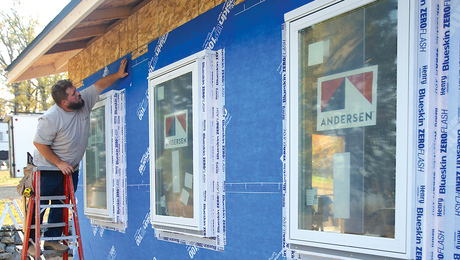I received two HVAC load calculations from my builder and I have a question regarding why some of the numbers changed. The second calculation was needed because the first one did not account for the upgraded wall insulation.
All of the numbers went down except the total Latent gain. I looked at the definition of this and some charts but I am not an HVAC guy, so I did not find a good explaination. rounded numbers:
The total heating changed from 81 000 btuh to 63 000 btuh;
The sensible gain dropped from 50 000 to 40 000;
The total latent increased from 11 000 to 12 000; and
The cooling required + vent dropped from 61 000 to 57 000;
Bldg supply CFM dropped from 2100 to 1900
I noticed that some other items changed also. they are as follows:
outdoor dry bulb changed from 10 winter/ 95 summer to 22 / 91;
no change in indoor wet bulb: 20 / 70;
Outdoor relative humidity changed from 100 winter/38 summer; to 80 / 46 %;
Indoor relative humidity no change at n/a and 50% (winter/summer);
Indoor dry bulb no change at 70/75 (winter / summer);
Difference gains changed from n/a & 30 to n/a & 37 (winter / summer).
This is for 4700 square feet, though I thought the house was 4300 square feet. I will ask the contractor about some of these, but wanted to see if anyone had any thoughts about why the values dropped except the latent heat. And if some of the inputs are sharpening (and how accurate are these calculations or are they just fodder for the customer and the government). I am most interested in not getting an oversized HVAC system.
Thanks!



















Replies
manual j's take into consideration a lot of details we dont know, latent heat should have decreased as well if you insulation type is foam.
very basically latent heat is the heat in objects: floor, chair, furniture, sheetrock, framing members....
you are correct in not wanting an oversized unit, specially if your upgraded insulation is spray foam. if oversized you could develop stale air, blasts of conditioned air that can not control the humidity in the house which could lead to a slew of issues like mold, mildew and all like these.
This is new construction, so there is no change in the design that I can see from the report. It lists room sensible and latent gains and losses. I have to assume some of the inputs Junkhound mentioned are not shown on the report.
The first analysis used a lesser wall insulation value, and that should have been all that changed. The insulation is R19 in the walls and floor and R30 in the ceiling. Walls are batt fiberglass, with Resnet grade 1 install in the contract. the grade 1 includes a barrier against air flow.
I will ask the contractor about the changes not shown.
Are the wetbulb/drybulb and humidity items chosen from standards for the area, or is that up to the user?
Thanks!
Latent heat gain is a type of heat gain that occurs when moisture enters a space and condenses, releasing heat. This can happen when humid air comes into contact with a cooler surface, such as a cold wall or window, and the moisture in the air condenses into droplets. This process releases energy in the form of latent heat, which can contribute to the overall heat load in a space.
Latent heat gain is an important consideration in building design and HVAC (heating, ventilation, and air conditioning) system sizing, as it can significantly impact the cooling load of a building. The amount of latent heat gain depends on factors such as the humidity level, air temperature, and surface temperature of the objects in the space.
To mitigate latent heat gain, building designers and HVAC engineers may use strategies such as increasing ventilation rates, dehumidification, or improving insulation and air sealing to prevent moist air from entering the space.